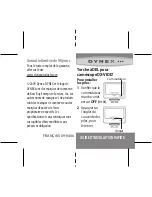
Using the Menu
86
b
Note
• When you connect your camcorder to outside power sources, [BRIGHT] is automatically
selected for the setting.
• When you select [BRIGHT], battery life is reduced by about 10 percent during recording.
A/V
c
DV OUT
You can connect a digital device and an analog device to your camcorder and
convert the signal transmitted from the connected devices to the appropriate signal
on your camcorder.
VIDEO INPUT
When you connect your camcorder to another device using the supplied A/V
connecting cable, set the type of plug you are going to use for the connection.
USB-CAMERA
You can connect a USB cable (supplied) to your camcorder, and view the picture
displayed on the screen of your camcorder on your computer (USB Streaming).
For details, refer to the “Computer Applications Guide.”
USB-PLY/EDT
You can connect a USB cable (supplied) to your camcorder, and view the picture
on the tape or “Memory Stick Duo” in your camcorder on your computer. For
details, refer to the “Computer Applications Guide.”
G
OFF
Select when not using the Digital convert function.
ON (
)
To output analog images and sound in digital format using your
camcorder.
The analog signal input to the AUDIO/VIDEO jack of your camcorder
will be converted and output from the DV Interface of your
camcorder.
For details, refer to the “Computer Applications Guide.”
G
VIDEO
Select to input a video signal.
S VIDEO
Select to input an S video signal.
G
OFF
Select to deactivate the USB Streaming function.
USB STREAM
Select to activate the USB Streaming function.
G
STD-USB
Select to view the picture on the “Memory Stick Duo.”
PictBridge
Select to connect the PictBridge compliant printer (p. 110).
USB STREAM
Select to view the picture on the tape.
















































